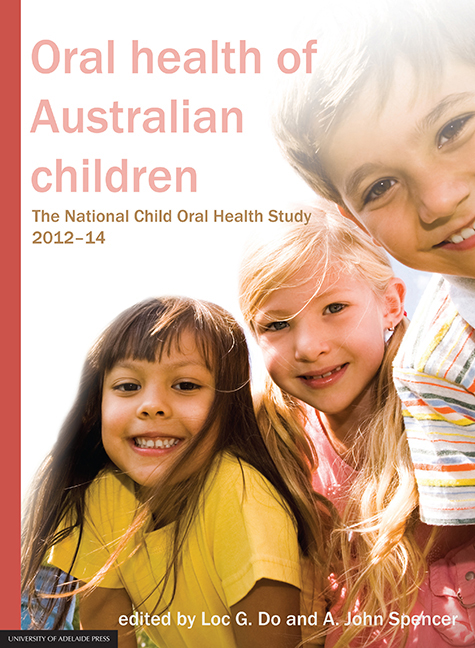Book contents
- Frontmatter
- List of Contributors
- Contents
- Preface
- Executive Summary
- 1 Children's oral health – assessing and improving oral health
- 2 Measuring child oral health and its influences
- 3 Data weighting, consideration and estimation procedures
- 4 Measuring representativeness of the study participants
- 5 Children's oral health status in Australia, 2012–14
- 6 Patterns of dental services use by Australian children
- 7 Australian children's oral health behaviours
- 8 Australian children's general health behaviours
- 9 Social gradients in child oral health
- 10 Oral health status and behaviours of Indigenous Australian children
- 11 Trends in child oral health in Australia
- 12 Interpretation of findings and a way forward to improving oral health and dental care
- 13 Appendix
- State and territory survey personnel
- Symbols
- Abbreviations
- Place names
- Glossary
- List of tables
- List of figures
5 - Children's oral health status in Australia, 2012–14
Published online by Cambridge University Press: 05 September 2017
- Frontmatter
- List of Contributors
- Contents
- Preface
- Executive Summary
- 1 Children's oral health – assessing and improving oral health
- 2 Measuring child oral health and its influences
- 3 Data weighting, consideration and estimation procedures
- 4 Measuring representativeness of the study participants
- 5 Children's oral health status in Australia, 2012–14
- 6 Patterns of dental services use by Australian children
- 7 Australian children's oral health behaviours
- 8 Australian children's general health behaviours
- 9 Social gradients in child oral health
- 10 Oral health status and behaviours of Indigenous Australian children
- 11 Trends in child oral health in Australia
- 12 Interpretation of findings and a way forward to improving oral health and dental care
- 13 Appendix
- State and territory survey personnel
- Symbols
- Abbreviations
- Place names
- Glossary
- List of tables
- List of figures
Summary
Introduction
Dental caries is the most common chronic infectious disease in childhood, caused by a complex interaction over time between acid-producing bacteria and fermentable carbohydrates (sugars and other carbohydrates from food and drink that can be fermented by bacteria), as well as many host factors including teeth condition and saliva (Fejerskov 2004; Fisher-Owens et al. 2007). Dental caries is characterised by the loss of mineral ions from the tooth (demineralisation), stimulated largely by the presence of bacteria and their by-products. Remineralisation occurs when partly dissolved crystals are induced to grow by the redepositing of minerals via saliva. The demineralisation of the tooth surface can be limited by the use of fluorides. Normally, a balance occurs between the demineralisation and remineralisation of the tooth surface (enamel). However, this balance is disturbed under some conditions, and the subsequent chronic demineralisation leads to the formation of holes or cavities in the tooth surface. In its early stages the damage can be reversed with the use of fluoride. Cavitation (a hole in the tooth) beyond the outer enamel covering of the tooth into the tissues can lead to a bacterial infection, which may cause considerable pain and require surgery or the removal of the tooth. Once the cavity has formed a filling is needed to restore the form and function of the tooth. Childhood caries is a serious public health problem in both developing and industrialised countries (Casamassimo et al. 2009).
At about the age of 5 or 6 years, children start losing their primary (deciduous/baby) teeth, which are replaced by their permanent teeth. Most children have lost all their primary teeth and have gained their permanent teeth (with the exception of wisdom teeth, which may erupt several years, or even decades, later) by the age of 12 years. Therefore, analyses of dental caries in adolescents only report the level of disease in permanent teeth. Younger children generally have a mixture of primary and permanent teeth, from ages 5 to 12 years. The convention is to report on these two sets of teeth separately.
Methods
Dental caries experience and other oral conditions were collected through oral epidemiological examinations. Didactic and clinical training for the examination teams was conducted. Frequent refresher sessions were also provided. Examinations were held in fixed or mobile dental clinics under standardised conditions.
- Type
- Chapter
- Information
- Oral Health of Australian ChildrenThe National Child Oral Health Study 2012-14, pp. 86 - 152Publisher: The University of Adelaide PressPrint publication year: 2016



